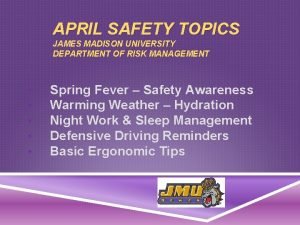WINTER SAFETY TIPS James Madison University Department of





- Slides: 5

WINTER SAFETY TIPS James Madison University Department of Risk Management www. jmu. edu. riskmgmt

Driving in the winter means changes in the way you drive. Snow, sleet and ice can lead to hazardous road conditions. Prepare your vehicle for the upcoming winter season with these helpful tips. • Never mix radial tires with other types of tires • If possible, avoid using your parking brake in cold, rainy and snowy weather • Do not use cruise control in wintery conditions • Look and steer in the direction you want to go • Accelerate and decelerate slowly • Increase following distance to 8 to 10 seconds • Know whether you have antilock brakes, which will "pump" the brakes for you in a skid • If possible, don't stop when going uphill • Keep your gas tank at least half-full • If you do get stranded, don't try to push your vehicle out of snow • Signal distress with a brightly colored cloth tied to the antenna or in a rolled up window

Avoid Strain while Shoveling snow is a major winter activity in many parts of the United States. Taking a few precautions can help you prevent unnecessary pain and suffering. • Do not shovel after eating or while smoking • Take it slow and stretch out before you begin • Shovel only fresh, powdery snow; it's lighter • Push the snow rather than lifting it • If you do lift it, use a small shovel or only partially fill the shovel • Lift with your legs, not your back • Do not work to the point of exhaustion

Treat Frostbite Immediately • Frostbite is an injury caused by freezing of the skin and underlying tissues. First your skin becomes very cold and red, then numb, hard and pale. Frostbite is most common on the fingers, toes, nose, ears, cheeks and chin. Exposed skin in cold, windy weather is most vulnerable to frostbite. But frostbite can occur on skin covered by gloves or other clothing. • Frostnip, the first stage of frostbite, doesn't cause permanent skin damage. You can treat very mild frostbite with first-aid measures, including rewarming your skin. All other frostbite requires medical attention because it can damage skin, tissues, muscle and bones. Possible complications of severe frostbite include infection and nerve damage.

Prevent Carbon Monoxide Poisoning Carbon monoxide detectors save lives, but less than one-third of American homes have one installed. With December and January at the peak of CO poisonings. Be sure to follow tips like these: • Replace the battery for your home’s CO detector each spring and fall • Do not heat your home with a gas range or oven • Never run a car or truck inside an attached garage.









